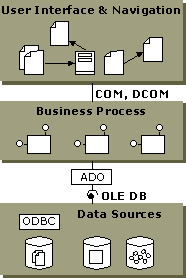
Microsoft ActiveX Data Objects (ADO) is a strategic application-level programming interface to data and information. ADO provides consistent, high-performance access to data and supports a variety of development needs, including creating front-end database clients and middle-tier business objects, and using applications, tools, languages, or Internet browsers. ADO is designed to be a data interface for one-to-multitier, client/server, and Web-based solution development.

ADO provides an easy-to-use application-level interface to OLE DB, which in turn provides underlying access to data. ADO is implemented with a small footprint, minimal network traffic in key scenarios, and minimal layers between the front end and data source. The result is a lightweight, high-performance interface. ADO is called using the COM automation interface, a familiar metaphor available from all leading rapid application development (RAD) environments, database tools, and languages on the market today. And because ADO was designed to combine the best features of Remote Data Object (RDO) and Data Access Object (DAO), and eventually to replace them, ADO uses similar conventions with simplified semantics, making it a natural next step for today’s developers.